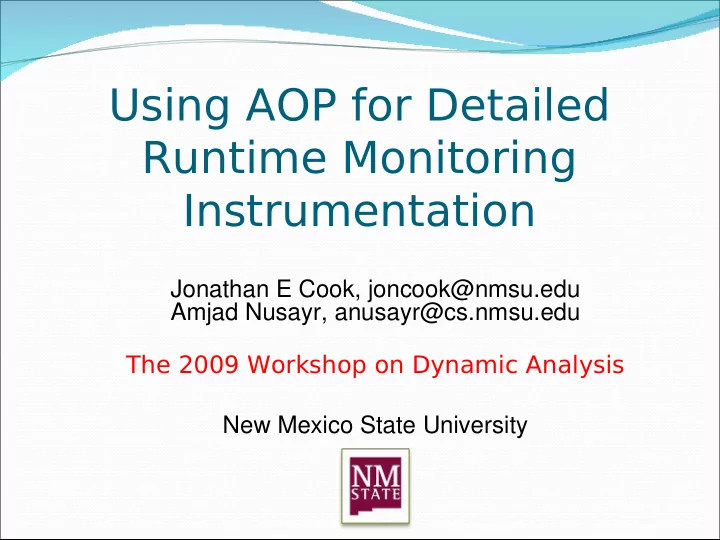

Using AOP for Detailed Runtime Monitoring Instrumentation Jonathan E Cook, joncook@nmsu.edu Amjad Nusayr, anusayr@cs.nmsu.edu The 2009 Workshop on Dynamic Analysis New Mexico State University
Runtime Monitoring The act of observing an executing system in order to learn something about its dynamic behavior RM needs an extremely wide variety of instrumentation mechanisms
Aspect Oriented Programming An elegant framework for constructing program behaviour that is orthogonal to the underlying program code base AOP is a natural fit for the domain of runtime monitoring
AOP Weaving vs Runtime monitoring instrumentation Advice to be weaved Code to be instrumented Init() Init() Method Exec Method Exec Exception Exception Underlying program
Aspect Oriented Programming Weaving: the process of instrumentation Advice: code that will be weaved Jointpoint: points in the program where advice can be weaved method call, object construction Aspect: an entity that holds all of the above
AOP for Runtime Monitoring Naturally captures the idea of scattered instrumentation in a base program Can be used on existing programs It is formal and uses normal programming concepts that programmers can readily grasp
AOP Deficiencies Not enough detail to cover all runtime monitoring needs e.g., statement level weaving, basic blocks, loops, local variable access Limited to weaving based on the source code Sampling-based profiling needs weaving based on execution time intervals rather than on places in the code
final double matgen(double a[][], final int n, double b[]) { ….. for (i = 0; i < n; i++) { for (j = 0; j < n; j++) { init = 3125 * init % 65536; a[j][i] = (init - 32768.0) / 16384.0; norma = (a[j][i] > norma) ? a[j][i] : norma; } } for (j = kp1; j < n; j++) { col_j = a[j]; if (l != k) { col_j[l] = col_j[k]; col_j[k] = t; } daxpy(n - (kp1), t, col_k, kp1, 1, col_j, kp1, 1); } ….. }
final double matgen(double a[][], final int n, double b[]) { Existing ….. joinpoints for (i = 0; i < n; i++) { Method Execution for (j = 0; j < n; j++) { init = 3125 * init % 65536; a[j][i] = (init - 32768.0) / 16384.0; norma = (a[j][i] > norma) ? a[j][i] : norma; } } Non-existing joinpoints for (j = kp1; j < n; j++) { col_j = a[j]; if (l != k) { col_j[l] = col_j[k]; col_j[k] = t; } Existing daxpy(n - (kp1), t, col_k, kp1, 1, col_j, kp1, 1); joinpoints Method Call } ….. }
Axes of Weaving Data space Weaving in code and data space current AOP coverage Code space Weaving in two dimensions
Axes of Weaving Time Time Data space extended AOP coverage Code space Extending the axes of weaving to a 3 dimensional view
Axes of Weaving Time Time Data space Code space Code space extended AOP coverage Sampling
New Code PCDs An extension in abc (AspectJ) New basicblock pointcut designator enables advice on every basic block New loopbackedge pointcut designator enables advice on every loop Both give reflective information Class and Method name (already existing) In-method unique ID (additional)
Basic Block PCD aspect TraceBasicBlocks { before(int blockID) : basicblock() && args(blockID) { System.err.println("Entering Block --> " + blockID + " at" + thisJoinPoint.getSourceLocation()); } after(int blockID) : basicblock() && args(blockID) { System.err.println("Exiting Block --> " + blockID ); } } }
Loop Backedge PCD aspect TraceLoops { before(int id) : loopbackedge() && args(id) { System.err.println("Loop body done, " + id + " at " + thisJoinPoint.getSourceLocation()); } }
AOP / RM Issues ABC was specifically created for extensibility, but is still limited When we tried statement-level advice, we were told “we never intended abc for that!” For RM, we implement before and after advice, but not around advice Would around be useful?
AOP / RM Issues ABC weaving occurs on an intermediate representation e.g., all loops translated to if-goto structures can we ensure source code fidelity? After advice misses final logical compare single JVM compare-branch instruction can be fixed with code duplication
AOP / RM Issues Ultimate goal: performance abc implements advice as method call can we rely on optimizing JVMs?
Examples Benchmark suite JTetris: Tetris game in Java Image2Html: converts a bitmap image into HTML Java Linpack, an implementation in Java of the FORTRAN Linpack routines Coverage analysis. Full instrumentation and Key class instrumentation Profiling Time Probability
Results Prob= .5 Prob= .5 Prob= .05 Prob= .05 Total Number of Time -------- -------- -------- --------- Application number methods no - Time - Time - Time Time of blocks and loops Instrumentation Block Loop Block Loop Instr Instr Instr Instr Java linpack 156 38 0.0675 0.572 0.335 0.271 0.187 J-Tetris 240 84 0.3275 0.547 0.435 0.439 0.339 Image2Html 409 39 0.6611 2.311 0.819 0.967 0.735
Future work. Continue to work new joinpoint types loop body, if-else body, case body time and probability dimensions Design, prototype, implement, test, and evaluate new pointcuts in the new dimensions Mechanisms for making reflective information easier and faster to obtain in the advice code will be needed
Thank y ou Questio ns ?
Sampling based profiling Weave Weave Weave on on on event event event time
Recommend
More recommend